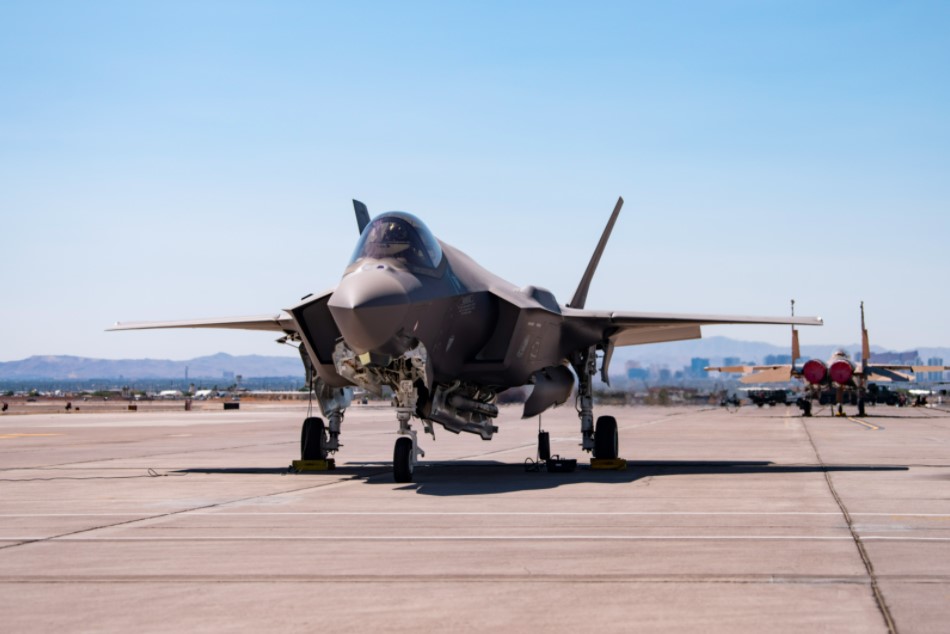F-35 Completes Final Test for Nuclear-Capable B61 Series Weapons
Oct. 5, 2021 | By Abraham Mahshie
Read online

“What happened was for the first time, an operationally representative F-35 aircraft executed a drop of a B61-12 Joint Test Assembly, which is basically exactly like a B61 that comes out of the nuclear stockpile without the physics package in it—the part that makes it go ‘boom,’” Kabel explained. “It can get closer, and with a gravity type of weapon, the closer you can get to your actual target, the more likely it is you’re going to hit it.”
American deterrence efforts came one step closer to a critical new level when the Air Force proved a stealth fighter is capable of delivering a tactical nuclear weapon inside hostile territory, Air Combat Command confirmed Oct. 4.
The F-35A is the first fifth-generation fighter to near certification as a nuclear-capable platform after completing the first full weapon system demonstration and completing the nuclear design certification process. During the demonstration, two F-35s dropped B61-12 Joint Test Assemblies (JTAs), which mimic a real-world tactical gravity nuclear weapon, at the Tonopah Test Range in Nevada.
“It makes our potential adversaries think more about their game plan before launching it,” Air Combat Command deputy director for strategic deterrence Lt. Col. Douglas A. Kabel told Air Force Magazine.
“It can get closer to, further inside a combat area that may otherwise be impossible for non-stealth assets,” Kabel added.
Air Combat Command’s 422nd and 59th Test and Evaluation Squadrons, based at Nellis Air Force Base, Nev., flew the final flight test exercise for the aircraft to receive nuclear design certification. Test data is now under review at the Department of Defense and Department of Energy to ensure the F-35A and B61-12 JTAs performed correctly.
The next step is nuclear operational certification to ensure training and validation of maintenance and air crews at desired wing locations where nuclear-capable F-35 missions exist. Approval would mean the United States has a fighter capable of hitting targets with tactical nuclear weapons inside hostile territory without detection.
“What happened was for the first time, an operationally representative F-35 aircraft executed a drop of a B61-12 Joint Test Assembly, which is basically exactly like a B61 that comes out of the nuclear stockpile without the physics package in it—the part that makes it go ‘boom,’” Kabel explained. “It can get closer, and with a gravity type of weapon, the closer you can get to your actual target, the more likely it is you’re going to hit it.”
Lt. Col. Daniel Jackson, headquarters ACC strategic deterrence and nuclear integration division chief, said the B61 series weapons can be used on other dual-capable aircraft such as the F-15E and F-16 C/D.
“Having a fifth-generation [dual-capable] fighter aircraft with this capability brings an entirely new strategic-level capability that strengthens our nation’s nuclear deterrence mission,” Jackson said in an Oct. 4 press release.
The F-35s used for the JTA test required two major hardware component modifications to take on the nuclear weapon, a nuclear consent switch in the cockpit, and a mission select switch in the weapon bay.
“The switch has to be in a certain position for the aircraft to recognize that it’s a new capable type of configuration,” Jackson said of the mission select switch, which must be engaged on the ground. “There is kind of an extra added safety measure, I would say, added to the jet as well.”
The nuclear certification process is broken into two phases: nuclear design certification and nuclear operational certification. This test conducted is considered the graduation flight test exercise for the F-35A’s nuclear design certification.
Jackson said that right now, the B-2 bomber is the Air Force’s only nuclear-capable stealth aircraft.
However, once certified, not every F-35 will become nuclear capable, Kabel said.
“At the end of the day, once the aircraft is design certified, it still has to be operationally certified,” he said. “That will be done at the location, the operational wing, that has the mission to utilize this.”
The two ACC officers declined to disclose a timeline or location for the operationally certified aircraft but indicated it would come soon.
“There’ll be an initial design certification here in the not-too-distant future,” Kabel said. “Then, follow on after that is the operational certification, which completes the process, making the F-35 a fully certified, dual-capable aircraft, and that capability is one that now we can put in the hands of the combatant commanders.”
